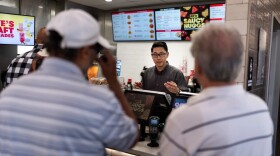"I model this series after the misbehaving trios that accompanied short silent films in the early 1900s," continues Paulson, "At one point the cost of a film projector went down in price and almost anyone who had a good year could afford to buy one, and any storefront could become a little movie theatre. The musicians that accompanied the films tended to misbehave after awhile - wouldn't you, after the 100th screening?"
As for the interactive part of the evening, Paulson [pictured at left] says he modeled that "after some of the traveling film exhibitors who visited small towns with movie shows. My favorite example of the era: townspeople were invited into an abandoned train car. A movie was projected onto one end of the train car. The film seen was shot from the caboose and engine of a real moving train. Secret sound effects were done live behind the movie screen by the exhibitor with assistance from some of the townspeople (who had gotten some quick training on percussion instruments and noisemakers). A couple more townspeople were paid to stay outside the abandoned train car and they gently rocked the car back and forth - all for the amusement of the paying customers in the car. Hey! Back then, cinema was THEATRE!!!!" [the caps and exclamation points represent the animated way Paulson expresses himself.]
Paulson started the Teeny-Tiny Pit Orchestra for Silent Films in late 1999 after having just gotten a "day job" at the UCSD Music Library.
"My first day at work," Paulson recalls, "I was asked to move all the 16mm films into the refrigerated closed stacks with the sound recordings. What a chore! But as I was sorting through all the 16mm films I noticed many of them were silent films. And as part of my training, I knew that the films had to be run through a projector once per year for preservation reasons. So, if they had to be put through a projector, why not really show the films to an audience and why not have live music while they run. Show these silent films the way they were meant to be shown!"
And so the silent film series was born.
"I spent all last year picking my favorite films to show this year," says Paulson, "The ArtPower people made me pick themes, which I hate doing, but I did it and it didn't kill the spirit of the series. My favorite theme: Women of the Silent Screen. The surprise of that theme was that I found so many women camera operators, directors, producers, screenwriters - lots of behind the scenes ladies of the silent era who were so fascinating! Today's moviemakers are sorely under-represented gender-wise compared to the silent era. For that show, I even used music from women composers of the era."
Rebecca Webb, the recently hired film curator at ArtPower, decided to collaborate with Paulson to keep the series going.
"We will be screening silent films by some of the most important pioneers in the history of French cinema," say Webb, "such as the Lumiere Brothers, George Melies, and Emil Cohl. In 1895 the Lumiere brothers invented the cinematograph, which projected motion pictures onto a screen for the first time. It was a portable three in one device - a camera, a printer, and a projector. We will also be screening the innovative films of cinemagician Georges Melies, who accidentally discovered the stop trick, and was one of the first filmmakers to use time-lapse photography, dissolves and hand painted color in his films."
Among the night's offereings is the 1908 film Une Dame Vraiment Bien by Louis Feuillade. The story involves a beautiful Parisian woman is so intoxicating to those who see her (men apparently can't concentrate in her presence and are prone to accidents whenever she's around) that she eventually requires a police escort to get home safely from her daily errands. Feuillade's work also inspired the recent French film Irma Vep by Olivier Assayas and starring Maggie Cheung.
Also screening is Les Joyeux Microbes by Emil Cohl and from 1909. The story concerns a scientist, his new microscope, and some happy microbes. The film serves up a mix of live action and animation. Silent shorts from the Lumiere Brothers and George Melies will also show.
But Webb plans to show more than just silent film as part of ArtPower. But Paulson only half jokingly notes, "My attitude is that 'talkies' are just a fad."
Maybe he's right. MoPA showed John Ford's silent classic The Iron Horse last year, and the San Diego Jewish Film Festival showed the silent His People with a live jazz ensemble, just last week. But His People left all the music and sound effects work to Paul Shapiro's jazz band. Paulson says of his event, "My goal is not to make fun of the movies, but I do want people to have fun performing along with the films. Please join me! I will save a solo for you: play a glissando on the harp! Use some exotic wooden birdcalls from France! Play a real Theremin, if you dare!!!!" If you are interested in trying out the Theremin, check out Paulson's performance and instruction on These Days.
These French films display a very different approach and style from the American silents that have recently played here. And Paulson's incredible energy and enthusiasm is bound to make the evening an absolute delight.
Tickets are $10 and can be purchased online at www.artpower.ucsd.edu or by calling the UCSD Box Office at 858.534.TIXS.
&
&






